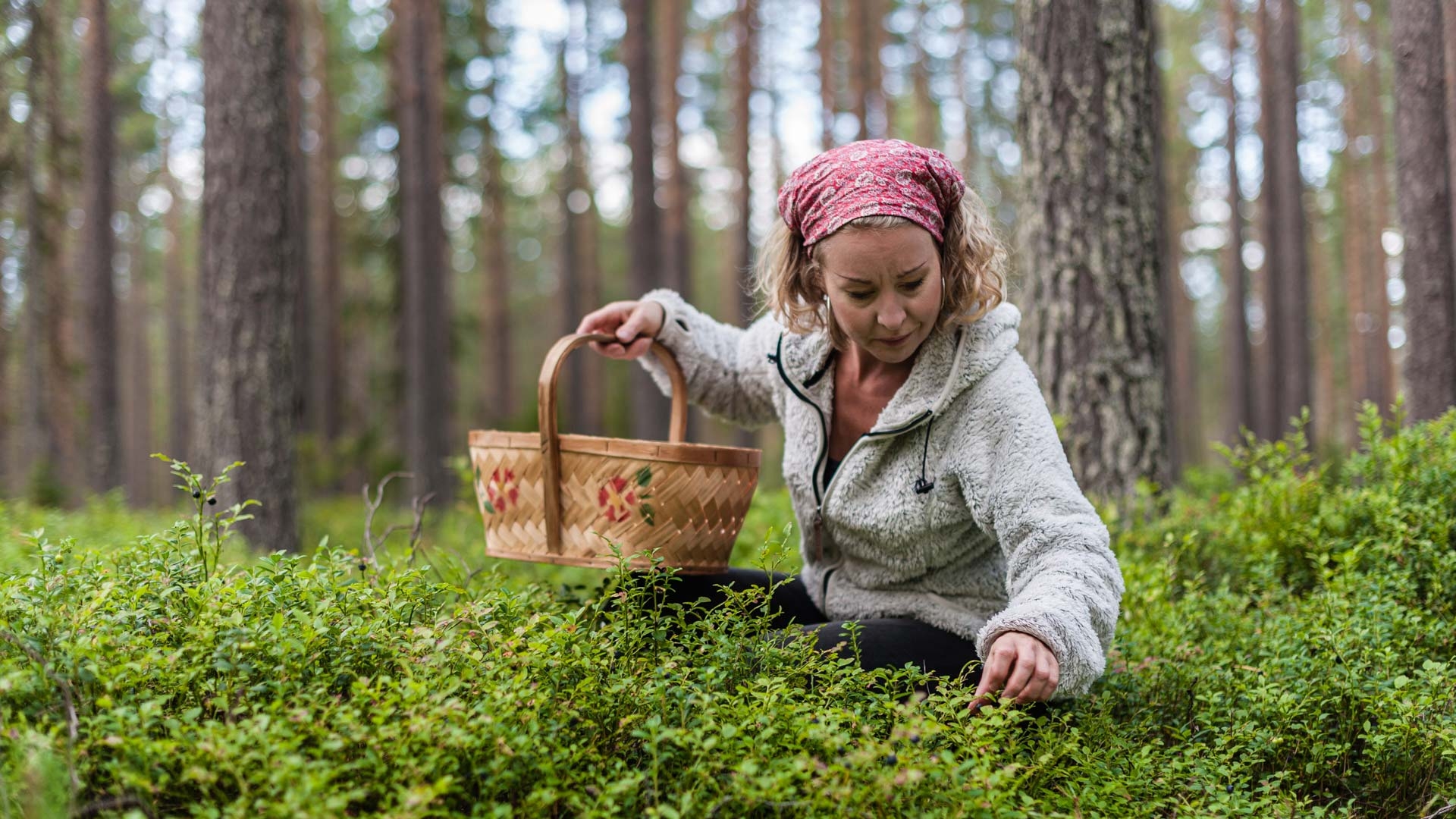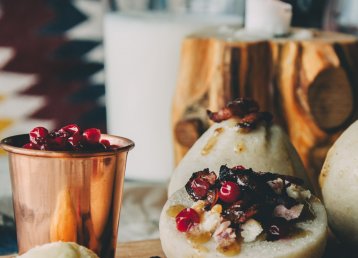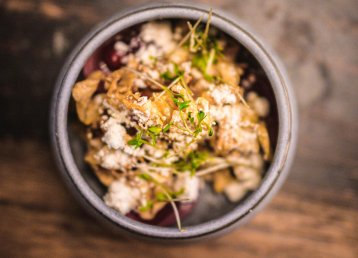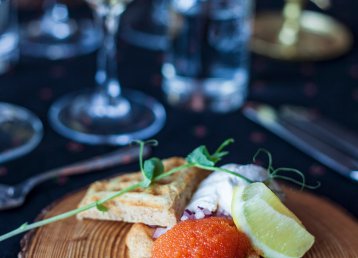On a Tuesday evening in June, I turn off route E45 just south of Avaviken. A short gravel road leads to a parking lot I have long intended to park in. I grab my rucksack and hike the steep path up to the top of what is known as Jan Svensa’s Hat (Jan-Svensamössan), a mountain with a significance that stands out to all who drive past. I always figured I would like to sleep up here, just for the sake of the view. Tonight is the night. The mountain is called Jan Svensa’s Hat because allegedly, there was a settler in Avaviken who had a tufted hat that resembled this low mountain. In Sámi, the name of the mountain is Suddale, which means “becomes ice-free early”. Those who often take this route along the Via Lappia know that this is true: the sun gets to the red porphyry early in the season, and the snow disappears. Something that was important for reindeer and reindeer herders to be aware of, as their food appears early here. I stop at the top. The view on a clear night goes on for miles and miles. Up here, on a low mountain and down there, lake Storavan – and in between forest, and more forest.
The freedom to roam
Parking your car and pitching your tent to experience nature is part of the Swedish freedom to roam that we have come to take for granted and embrace. There is a beautiful place to enjoy almost everywhere: a mountain, a perfect bay for a swim, a primaeval forest or a roaring riverside. Later in the season, this part of the country will feature cloudberries, then blueberries and lingonberries, and I will be able to pick them all. Likewise, if mushrooms and edible herbs grow here on Suddale, I am free to pick those too – unless the reindeer have been here before me, of course, as they are also partial to mushrooms.
I find a nice spot where I pitch my tent. There is already a fireplace prepared, so I make fire using some branches I found further down in the forest. Making a fire on someone else’s land isn’t part of the freedom, quite the opposite. But since there is an old fireplace here and I use branches that I found along the path, it is a nice addition to the late summer night. The freedom to roam does not come with many rules, and what is not regulated is – in principle – allowed. But some things are regulated, of course. For example, not being allowed to damage other people’s forest or fences, but there is not much more to it than that. Common sense is the guiding principle: do not damage and do not disturb. Spend time in nature as if you were a nomad, and be considerate of others.
Allemansrätten – in short
- Sweden’s right of public access is a customary law. It’s been a part of our tradition to camp and forage since “forever”. The same goes for travelling, on foot, bike, horse, or canoe.
- The general rule is simple: “Don’t disturb – don’t destroy”. You can tramp almost everywhere, but gardens and homes are still private.
- You can pick wild berries and mushrooms, but not cultivated ones. Don’t litter. What you bring with you in – you should take home with you.
- And don’t become visual litter; place your campsite away from people’s private sphere. You are not allowed to ruin anyone’s forest or fences.
- You are not allowed to light a campfire anywhere, but many places have a fireplace already.
- Consider yourself a nomad – don’t settle in, leave no footprints. Take the chance to enjoy this possibility and freedom to roam. But always respect man and nature.
The edible country
Some days later, I find myself sat at a table in the forest just west of the village Liehittäjä, where Pia and Henry Huuva run their amazing Huuva Hideaway. This table is one of several tables around Sweden presented as a concept for the Visit Sweden campaign The Edible Country. The campaign was a way of communicating the possibilities of the freedom to roam – that all of Sweden is a pantry. Go out and forage what you can eat, then cook it in the forest. A clever way of presenting the freedom to roam, with the entire country available for bookings, like a restaurant. In Swedish Lapland, there are two of these tables. Henry Huuva himself built the one here in Liehittäjä. The other was built by interior carpenter Anton Fahlander in Luleå and can be found on Skeppsholmen in Arjeplog, with the mountains and Sweden’s deepest lake as a backdrop. In Liehittäjä, Henry has picked the shoots of willowherb, also known as fireweed, that he will fry over an open fire. Willowherb is sometimes called poor man’s asparagus, but I wonder who is poor? Those who can eat fried shoots from wild willowherb out in the forest on a summer’s day such as this, or those who buy plastic-wrapped items in the shop.
Natural flavours
After the willowherb starter, we get ‘dip in a cup’ (dopp-i-kopp). A dish that could well be called the national dish of the Torne Valley. This was the old way of using tiny potatoes that could not be used in any other way. They were quickly boiled in a pot, then dipped in melted butter. Dip in a cup works well with cured salmon or pickled grayling if you ever find it. But it used to be those tiny potatoes and the salty butter that gave you the energy to last the day.
After the dip in a cup, there is suovas, lightly smoked and thinly sliced reindeer meat fried in a pan over the fire, then eaten on gahkku, Sámi flatbread. Very apt, as this table is placed in the middle of an old, disused reindeer corral.
Poor man’s asparagus
Swedish Lapland is famous for its flavours of game, fish, and freely –roaming animals – pretty much no added hormones or antibiotics at all. Food charged with the energy of the midnight light means that three months’ sunlight is packed into two calendar months, and the food and the flavours become clean, local, and Arctic. The forest is our pantry, naturally. The native people and later settlers would eat greens and the berries available. Pine bark, or bark bread, used to be called poor man’s flour, but now people have realised just how good it is for you. The first shoots of birch leaves, called ‘mouse ears’, are filled with sugar and vitamins, just like spruce shoots. We are not allowed to pick shoots from trees any way we like. That is not part of the freedom to roam because the owner of the forest owns a tree. But in the beginning, this land was not mine; it was ours, and the way hunters in the north would supplement their protein was by using this fresh greenery. Light-green, baby greens, the first of the year, from the pantry that is the forest, or the side of the road.
So back to our poor man’s asparagus, that have finished frying at Huuva Hideaway. They are just a reminder that there are plenty more green things to gather from the roadside pantry.
Book a table
In collaboration with four Michelin-starred chefs, Visit Sweden have created inspirational menus featuring local produce to help you experience the Swedish pantry. Two of these bookable tables are in Swedish Lapland. One at Huuva Hideaway in Liehittäjä and one at Skeppsholmen in Arjeplog.
Meadowsweet, or meadsweet
— The first years I lived in Jokkmokk, I didn’t really think much about what you could eat from nature other than the obvious, such as berries and game. It took a while, and I think it was the angelica that made me understand how versatile the world of plants really is. Food entrepreneur Eva Gunnare tells me one day when we meet up in Kalix to pick meadowsweet.
Eva has created a mulled wine in cooperation with Norrbotten Destilleri in Töre, based on meadowsweet. Its Swedish name is ‘elk sweet’, funnily enough, because elks do not eat it. However, the proper name should be meadsweet, as it was one of the first plants used in the north to brew mead and later beer. But meadowsweet can easily be turned into a nice drink: just place it in cold water for a while and then strain before serving. Unless you want to make your own mulled wine, of course.
The roadside pantry
Angelica grows almost all over the country. People were writing about it already back in the 13th century, and the Vikings who settled on Iceland, Greenland and the Faroe Islands brought angelica with them. On Iceland, angelica was given the same status and protection as fruit trees in Swedish legislation.
Another thing you find along the road are dandelions, and those shoots are tasty too. They have a nutty flavour when fried and can be pickled like capers. If you pick the petals and are patient enough, you can boil them and reduce them to make the tastiest syrup. The green dandelion leaves are like a Nordic rosso salad: mix them with sorrel, or alpine sorrel, to get a true Northern green salad.
The Sámi used to boil sorrel and alpine sorrel in water until it became a porridge, eaten with milk back then, but now perhaps with cream and a bit of sugar. This dessert, called juobmo, tastes a lot like rhubarb.
Early in the season, there are nettle shoots to pick, the first true vegetable of the season in this part of the world that can be made into a tasty, classic soup but is also excellent in a homemade pesto. So, there in the ditch, you have an entire pantry of flavours from nature, with stinging nettles, dandelions, meadowsweet, sorrel, angelica, and willowherb. But, of course, you can make other things too, not just food. The edible country is, of course, also the drinkable country.
The Drinkable Country
— Yes, I did win all the competitions I could win as a bartender, and then I wrote a cocktail book that also won prizes. The key was probably bringing the flavour of our nature to the recipes. It was a natural thing to do; that’s where the Swedish flavour is, says bartender Emil Åreng.
— You know, mint – they’ve already done that in a Cuban mojito. To me, a midsummer drink is more about spruce shoots and birch leaves.
When Emil lets me have a taste, the infusion he has just taken off the camping stove is nothing other than the pure taste of a Swedish summer forest. Birch leaves and spruce shoots in syrup with a little bit of lemon. It tastes as if the most Swedish thing of all – the forest – is really there, inside the glass. Emil Åreng is perhaps Sweden’s most famous bartender, simply put. He has created four drink recipes for Visit Sweden’s campaign, The Drinkable Country. Initially, the idea was that they would cover all seasons and that you would be able to find the ingredients in nature during all months of the year, but what does a metre of snow and ice taste like here in the north? So Emil made two summer drinks and a very late autumn drink instead, using frozen rowanberries.
— This midsummer drink I made in two versions because you never know if Swedish midsummer will be balmy or chilly. If you serve it hot, add some whipped cream on top. If you can serve it cold, just put ice cubes in the glass instead. Both versions work equally as well, just like a Swedish midsummer. The main thing is that you get to spend time outside.
Rich flavours
For a few days, Emil Åreng visits Liehittäjä to help Pia and Henry with some practical things and relax a bit in the forest. Or perhaps to gather provisions. The landowner has permitted him to pick both ‘mouse ears’ and spruce shoots. He says several generations of his family were foresters, so his own career path was not entirely obvious. What was obvious was where to find the flavours for his award-winning cocktail recipes.
— We have such incredibly rich flavours here. It’s not like we need mango in Sweden when we have sea-buckthorn. We can use it in our drinks. We just have to discover everything we can do with it.
Henry brings the suovas, ready to eat. Gahkku and trimmings are already on the table. But, before we all dig in, our wooden cups are raised in a toast, ice chinking. It is warm, and the flavour of Swedish summer forest fits just perfectly, just right.
Emil's drink recipes
Spring drink
Ingredients:
20 nettles leaves
50 birch leaves
30 g of citric acid
200 g of sugar
500 ml of water
Seltzer or soda
Ice
Garnish: Blueberry leaves
Glass: Guksi or cup
Alcohol to add if you wish: 50 ml gin
Method: Warm water and citric acid. Add birch- and nettle leaves (use gloves). Heat everything together with the sugar. Strain the mixture and pour it into a cup with ice. Add gin (optional) and seltzer or soda.
Tools: Gloves, strain, jigger
Summer drink – warm
Ingredients:
A handful of young green birch leaves
A handful of spruce shoots
100 ml of lemon juice
600 ml of water
250 g of sugar
Ice (optional)
Garnish: Young green birch leaves
Glass: Highball glass
Alcohol to add if you wish: 50 ml aquavit
Method: Heat water, sugar, lemon juice, birch leaves and spruce shoots. Bring to a boil. Strain the mixture and pour it into a highball glass. Add aquavit (optional). Can be served hot or cold on ice.
Tools: Strain, jigger
Summer drink – cold
Ingredients:
A handful of wood sorrel
A handful of meadowsweet
30 ml of lemon juice
50 ml of spring water
Ice or 1 big ice cube
*Syrup
Glass: Whisky glass
Alcohol to add if you wish: 50 ml gin
Method: Heat the meadowsweet in a decent amount of syrup. Leave to simmer for 5 minutes and strain. Add wood sorrel, lemon juice, water and ice and shake for approximately 10 seconds. Add gin (optional). Pour into a whisky glass.
Tools: Strain
Autumn drink
Ingredients:
A handful of rowan berries
A handful of lingonberries
A handful of juniper berries or blueberries
100 ml of seltzer or alcohol-free sparkling wine
500 g of sugar
1 litre of water
Garnish: Rowan berries
Glass: Whisky glass or guksi
Alcohol to add if you wish: 50 ml gin
Method: Heat rowan berries, lingonberries, juniper berries/blueberries and crush them together with water and sugar. Strain the berries and pour them into a glass. Top with alcohol-free sparkling wine or seltzer. Add gin (optional) and garnish with rowanberries.
Tools: Strain, jigger
*Syrup recipe
Ingredients for 330 ml
300 ml sugar
300 ml water
Method: Add sugar and water to a small pan/pot over medium heat. Stir until sugar is dissolved. Let cool, pour into a glass jar and seal tightly with a lid. The syrup will keep refrigerated for about one month.












































